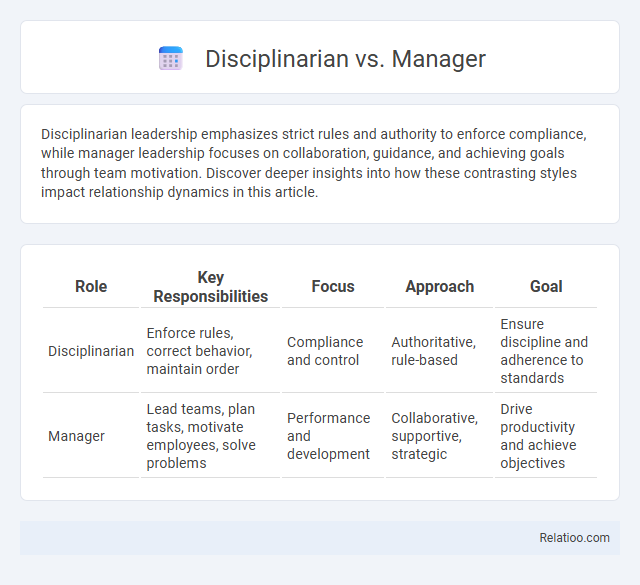Disciplinarian leadership emphasizes strict rules and authority to enforce compliance, while manager leadership focuses on collaboration, guidance, and achieving goals through team motivation. Discover deeper insights into how these contrasting styles impact relationship dynamics in this article.
Table of Comparison
| Role | Key Responsibilities | Focus | Approach | Goal |
|---|---|---|---|---|
| Disciplinarian | Enforce rules, correct behavior, maintain order | Compliance and control | Authoritative, rule-based | Ensure discipline and adherence to standards |
| Manager | Lead teams, plan tasks, motivate employees, solve problems | Performance and development | Collaborative, supportive, strategic | Drive productivity and achieve objectives |
Understanding Disciplinarian and Manager Roles
Understanding disciplinarian and manager roles involves recognizing that disciplinarians primarily enforce rules and correct behavior to maintain order, while managers focus on planning, organizing, and guiding teams to achieve organizational goals. Disciplinarians emphasize adherence to policies and consequences for violations, ensuring a structured environment. Managers balance leadership, motivation, and performance evaluation to optimize productivity and foster employee development.
Key Differences Between Disciplinarians and Managers
Disciplinarians primarily focus on enforcing rules, correcting behavior, and maintaining order, whereas managers emphasize organizing tasks, motivating teams, and achieving organizational goals. Disciplinarians use a more authoritative approach to ensure compliance, while managers employ leadership skills to foster collaboration and productivity. The key difference lies in disciplinarians prioritizing control and discipline, while managers concentrate on strategic planning and team development.
Leadership Styles: Command vs Collaboration
Disciplinarians lead with a command style, enforcing strict rules and expecting compliance to maintain order, while managers blend directive leadership with collaboration, emphasizing goal achievement through team coordination and communication. Collaborative leaders prioritize employee engagement and input, fostering trust and innovation, whereas disciplinarians focus on authority and control to ensure discipline and efficiency. Understanding these leadership styles helps organizations balance structure with flexibility for optimal performance.
Impact on Workplace Culture
Disciplinarians often foster a rigid workplace culture emphasizing strict rules and consequences, which can lead to decreased employee morale and innovation. Managers typically balance authority and support, promoting a collaborative environment that encourages engagement and productivity. Leadership combining disciplinary measures with managerial flexibility tends to create a positive, accountable workplace culture that drives both performance and employee satisfaction.
Employee Motivation and Morale
Differences between disciplinarians, managers, and disciplinarians in employee motivation and morale lie in their approaches: disciplinarians enforce strict rules to maintain order, often leading to reduced morale, while managers balance task completion and employee well-being to foster motivation and engagement. Effective managers use positive reinforcement and open communication to enhance job satisfaction, whereas overly authoritarian disciplinarians risk creating a fearful work environment. Emphasizing leadership styles that prioritize empathy and clear expectations promotes higher employee motivation and sustained morale.
Conflict Resolution Approaches
Disciplinarians often rely on strict rules and consequences to handle conflicts, emphasizing authority and compliance, whereas managers prioritize collaborative problem-solving and open communication to resolve disputes effectively. You benefit most by adopting a balanced conflict resolution approach that combines a disciplinarian's structure with a manager's flexibility, fostering both accountability and cooperation. Disciplinarians may enforce discipline to prevent repeated issues, but managers work proactively to understand underlying causes and build long-term team harmony.
Communication Techniques and Effectiveness
Disciplinarians emphasize direct, authoritative communication to enforce rules and maintain order, often prioritizing compliance over collaboration. Managers use a balanced approach, combining clear instructions with active listening to motivate teams and foster productivity through constructive feedback. Effective communicators adapt techniques from both roles, ensuring clarity and discipline while encouraging dialogue and employee engagement for optimal results.
Enhancing Team Productivity
A manager focuses on organizing resources and setting clear goals to drive team productivity, while a disciplinarian emphasizes enforcing rules and maintaining order to prevent disruptions. Balancing both approaches ensures your team remains motivated and accountable, fostering a productive work environment. Integrating leadership with discipline enhances efficiency and promotes consistent performance outcomes.
Adapting Leadership Styles for Success
Adapting leadership styles involves recognizing when a disciplinarian's firm enforcement of rules is necessary versus when a manager's focus on delegation and motivation better suits team dynamics. Successful leaders blend disciplinarian traits, such as maintaining order and setting clear expectations, with managerial skills like communication and strategic planning. Flexibility in shifting between strict discipline and collaborative management enhances organizational effectiveness and fosters a positive work environment.
Choosing the Right Approach for Your Team
Choosing the right approach between disciplinarian and manager styles depends on your team's needs and organizational goals. A disciplinarian enforces strict rules to maintain order, promoting accountability through clear consequences, while a manager focuses on motivation, collaboration, and developing employee potential. Balancing authority with empathy enhances productivity, fosters trust, and creates a positive work environment tailored to team dynamics.

Infographic: Disciplinarian vs Manager
 relatioo.com
relatioo.com